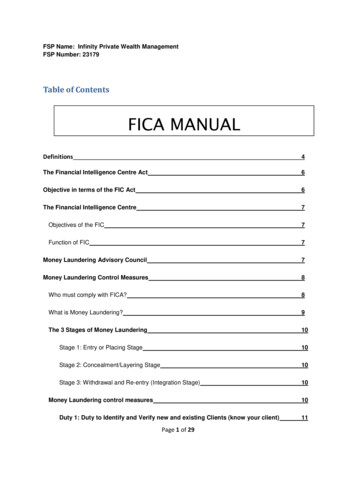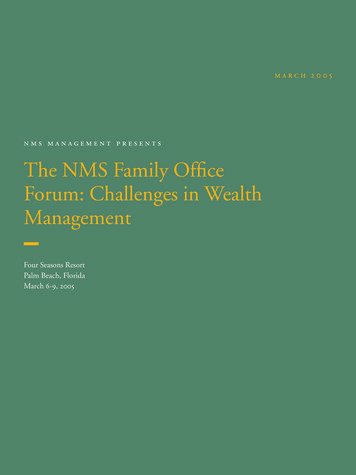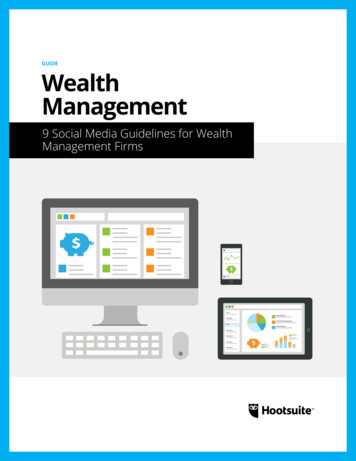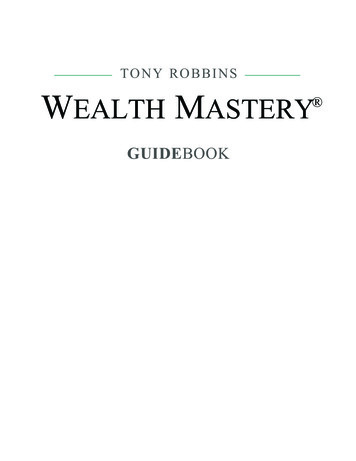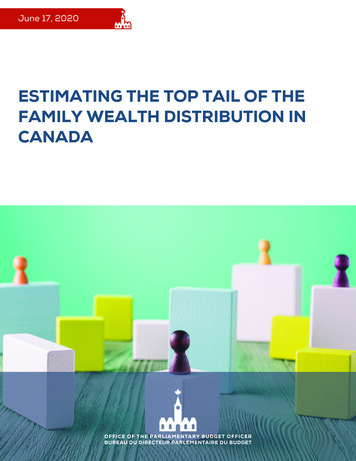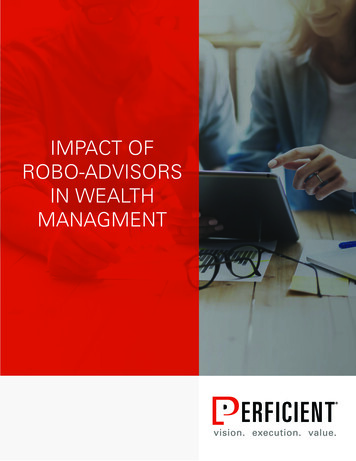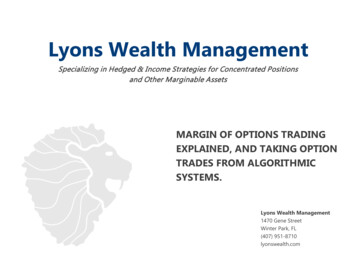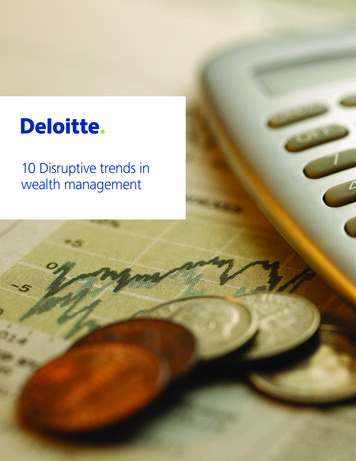
Transcription
10 Disruptive trends inwealth management10 Disruptive trends in wealth managementi
1
IntroductionWealth Management (WM)1 is one of the most attractivesectors within financial services for at least two reasons:First, WM businesses tend to have greater growthprospects, lower capital requirements, and a higher returnon equity (ROE) than most other retail banking businesses,hence their appeal to diversified financial services firms at atime when capital is viewed as more expensive, growth ishard to come by, and equity returns for the banking industryare close to the cost of capital. Second, WM offeringsare essential to attracting and retaining profitable retailcustomers. For instance, based on our experience, massaffluent customers can typically represent 80% or more ofthe net income generated by retail banks and they oftenregard their relationship with a provider of WM services astheir most important financial relationship. As result, manydiversified financial services firms are doubling down ontheir WM businesses.We define WM as the provision of financial advice and investment servicesto retail investors, ranging from low-income clients to High Net Worth(HNW) and Ultra High Net Worth (UHNW) individuals and families.The WM industry is in the midst of significant change:a new generation of investors, whose expectations andpreferences have been shaped by new technologiesand by their living through the last financial crisis, havebrought new standards to the industry in terms of howadvice and investment products are being delivered. Thesenew investors will control an increasing share of US retailassets over the next decade. Furthermore, a challenginginvestment environment, characterized by increased levelsof uncertainty and rising costs of risk to investors and WMfirms alike is making it harder for advisors to generatesuperior investment performance for their clients. Shiftingdemographics with the aging of advisors and an upcomingtransfer of wealth from baby boomers to their childrenwill upset many established advisor/client relationships andcreate opportunities for new firms to grow market share atthe extent of incumbent firms. Finally, increasing regulatoryburdens, new business models and new competitivepatterns all come together to further compound the level ofdisruption in the WM industry.110 Disruptive trends in wealth management2
We have identified 10 principal sources of disruption in the WM industry today (Fig. 1. the Wheel of Change is Turningon Our Industry). They are not independent of each other but rather tend to build on each other. Together they couldprofoundly change our industry in the next decade. WM firms will need to adapt to these disruptors and find new ways tocreate value for their clients.New firms and new business models as well asrenewed commitment by incumbent WM firms willdrive higher intensity of competition for the sameclients and the same assetsA new generation of investors think differentlyabout advice bring new attitudes and expectationsto the WM industry, influencing how olderinvestors purchase and consume wealth services1NewTheWith the rise of Robo Advisors, new2CompetitiveRe-wiredcombinations of science and human basedPatternsRisingInvestoradvisory models have emergedScience- vs.Costs of Riskand IncreasingHuman-basedRegulatory9Big data and advanced analytics are onBurdens3the cusp of transforming the WM industry,10DisruptorsMacrowith new ways to engage with newEnvironment: 3Analyticsto Wealthclients, manage client relationships andand Big DataLows and 2 Highs10Increasing regulatory burdens and risingcosts of risks pose new challenges toWM firms and their parent companiesThis is a challenging macro environmentfor investors and their advisors to findthe right return/risk combinations8Two demographic trends: (i) Advisors areaging and leaving the industry faster thanfirms are replacing them; (ii) Wealth is aboutto change hands, upsetting establishedclient/advisor relationshipsManagementIndustryThe Agingof Advisors &UpcomingTransfer ofWealth Catchingthe7RetirementWave6Longevity concerns increasingly are or should be at the heart ofclient-advisor conversations, even years ahead of retirement3Democratization of AssetClasses &Strategiesmanage risksHolistic,Goals-basedAdvice54Investors value holistic advice on howto achieve multiple, often conflictinggoals through a range of investment andfunding strategiesRetail investors are demanding access to the same assetclasses and investment strategies as HNW or institutionalinvestors
1. The re-wired investorWe speak of the Re-wired Investor to refer to new thinkingpatterns, standards and expectations by a new generationof investors. This new generation of investors include GenX and Gen Y2 investors, but also baby boomers who havebeen influenced by their younger peers.The Re-wired investor thinks about advice differently fromprevious generations and expects to interact with her advisorsin a different way. We have identified 9 new “mentalities”and six potential implications for WM firms (see Figure 2). Forinstance, investors no longer want to be treated as part of asegment but instead as unique individuals (“Just me”) withspecific goals and preferences. Instead they expect to receiveadvice tailored to their unique circumstances.Likewise, they want to stay in control of their financiallives and understand the advice they receive and make theimportant decisions themselves. They are reluctant to buydiscretionary services and they are increasingly comfortableconducting their own research.The Re-wired Investor is more skeptical of authoritythan previous generations of investors. She believesin the wisdom of her peers. As a result, she is likely toseek opinions and views from multiple sources of advicesimultaneously, including but not restricted to expertsand financial advisors and often starting with people likeher friends and colleagues. With her expectations shapedby her interactions with non-financial digital firms (e.g.,Google, Facebook, Amazon) as well as smartphones andother digital devices, she expects to be able to access adviceanywhere and at any time, through multiple channels anddevices as part of a cohesive, rich digital experience.The Re-wired Investor has come to view risk through adifferent lens: she perceives risk as downside, rather thanvolatility. As a result, advisors have had to emphasizecapital markets and hedging strategies that seek downsideprotection more than traditional portfolio allocations thatseek to manage risk through diversification.Lastly, she feels entitled to the same investment products andstrategies available to Ultra High Net Worth (UHNW) or eveninstitutional investors forcing WM firms to think throughnew ways to give their retail investors access to alternativeinvestments and new asset classes beyond traditional fixedincome and equities, as well as active strategies.The Re-wired Investor is likely here to stay—and herinfluence over the rest of the investor class is likely toincrease. Accordingly, WM firms and their advisors shouldadjust their offerings and service delivery models to “win thebattle” for the Re-wired Investor—the investor of the future.Figure 2: The Re-Wired InvestorThe Re-wired investor is here to stay and his influence over the rest of the USinvestor class is likely to increase.Mentalities of the Re-Wired InvestorJust meDo it yourselfAnywhere, anytimeMulti-channelAccess to multiple channels and severaladvisory models at the same timeMultiple sources of adviceNot just from one advisor, but from otheradvisors, peers, experts, social mediaDigital & PersonalWisdom of my tribeRisk defined as downsideNot a Second Class InvestorGen X, the approximately 45 million Americans born in thelate 1960s and 1970s, and Gen Y, the approximately 60 millionAmericans born in the 1980s and first half of 1990sBespokeInvestment advice and products perceivedto be tailored to individuals one at a timeStay in controlSkeptical of authority2Implications for WM firmsRich digital front endExpectations formed interacting with nonFIs; must be simple, intuitive, self-directedRisk Management as HedgingDownside protection and hedging morethan diversificationDemocratization of investmentsAccess to same high yield assets & strategiesonce available only to wealthier investors10 Disruptive trends in wealth management4
2. Science vs. Human-based adviceTechnology is poised to change the nature and delivery offinancial advice in some significant ways, much as it hastransformed other industries such as tax preparation, taxibooking, and accommodations, to mention just a few.In the last five years, a number of “robo advisors” haveemerged. These firms leverage client survey data intocomplex algorithms that produce customized financialplans and asset allocations. They also help investors findrelevant research within an ever-growing universe ofstudies, interviews, and market commentaries. Some firmshave also pioneered tools and methodologies that generatereal-time trade and investment recommendations tailoredto individual investors’ history and preferences. Once themodels and algorithms have been built and tested, investingand trading tools can be made available to customers withlimited human intervention, emphasizing the shift fromhuman-based, person-to-person advice to science-based,model-driven advice.Robo advisors are growing in popularity and have gainedtraction in the marketplace but still have quite a bit of roomfor growth. A survey by consulting firm Corporate Insightfinds that total assets managed by the 11 leading roboadvisors in the US rose 65% over the past year, hitting 19billion in December 2014.3 While significant, this figurerepresents less than 0.1% of the 33 trillion retail investableassets in the US.4 Furthermore, with aggressive pricing( 0.3% of AUM)5 the potential for the current generationof robo advisors to generate meaningful bottom line andcreate a return for the Venture Capital firms behind many ofthem is still unproven.Nevertheless, robo advisors present the potential forsignificant market disruption. For one, their businesses arebuilt on a solid premise: some forms of advice (especiallyinvestment advice such as asset allocation or fund/stock picking) can effectively be produced and deliveredthrough technology. This approach is especially attractive“Notes on Retirement: Total AUM Increases for 11 Leading Robo-Advisors,” Mark Miller,Wealth Management.com. December 22, 2014 (link: Corporate Insights Survey)4“US Households Control 33.5 Trillion in Investible Assets,” InsuranceNewsNet.November 12, 2014 (link: Insurancenewsnet.com)5Fee analysis of leading robo advisors Wealthfront and Betterment35for investors who are technology-savvy and want to havegreater control over their financial lives—the Re-wiredInvestor of the future that we profiled above. Whilerobo advisors have not had the distribution and accessto investors to grow fast so far, this may be about tochange: incumbent WM firms with deep pockets and widedistribution capabilities are now either developing in-housecapabilities or by partnering with some leading roboadvisors. With access to large pools of investors, establishedand well-funded companies could drive rapid adoptionof new forms of science-based advice and create newexpectations for the rest of the market.However, we do not believe science-based advice will fullydisplace human-based advice, nor are robo advisors likely todis-intermediate financial advisors in a major way. Rather,we may see a not-too-distant future where science-basedadvice may draw customers who could not previously afforda personal advisor or were not comfortable with humanbased advice—potentially expanding the advice market. Wecould also see winning advisory models combine elementsof the science and human-based advice models into a hybridmodel. The balance between the two will likely vary acrossinvestor segments (see Figure 3: Human vs. Sciencebased Advice) based on investors’ ability to pay for advice,the complexity of financial needs, their self-confidence,and financial background, etc. Furthermore, investors arelikely to continue to seek personal advice for needs thatreach beyond investment (e.g., tax and estate planning)or involve emotional issues (e.g., securing health care forelderly parents). Financial advisors should try to harnessthe power of science-based advice to effectively outsourcesome aspects of their work while focusing their time on theelements of advice where they can add most value to theirclients and differentiate themselves. Incumbent WM firmswill need to invest in building the technology platforms andtools that will enable this hybrid advisory model.
Figure 3: Science vs. Human Based AdviceThe “winning” advisory model will likely be a hybrid model that combines the best elements of science and humanbased advice, taking into account differences in needs and willingness to pay across the client wealth spectrumNature of Advice“Human-Based”More SimpleNeeds (e.g., assetallocations, MutualFund selection)More Complex Needs(e.g., Tax & Estate,Multi-Currency, Assets/Liabilities, EsotericInvestments)The winning modelis a hybrid model(except at the twoends of the clientwealth spectrum)“Science-Based”Client Wealth Spectrum10 Disruptive trends in wealth management6
3. Analytics and big dataAs volumes of consumer data continue to growexponentially—in 2012, 2.8 zettabytes of data werecreated, and this figure is expected to grow to 40 zettabytesby 20206—new technologies have emerged to help processmake sense of it. As a result, Big Data is in the processof revolutionizing entire industries (e.g., retail, consumergoods, healthcare). With leading WM firms now investingin building more advanced analytics and data managementcapabilities7), the industry could be poised to go throughthe same kind of transformation.While most WM firms currently use fairly simple analyticsbased on MIS and reporting systems, to deliver key b
Financial advisors should try to harness the power of science-based advice to effectively outsource some aspects of their work while focusing their time on the elements of advice where they can add most value to their clients and differentiate themselves. Incumbent WM firms . 10 10. 10. Management Management Management. 10 Disruptive trends in wealth management .


